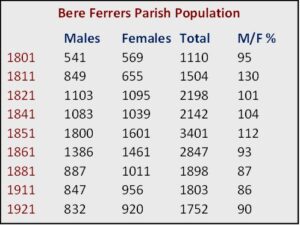Population
Changing population totals on the Bere Peninsula, 1801-1921

-
There were two periods of rapid population growth on the Bere Peninsula: in the first two decades of the 19th century and from 1841 to 1851. In both cases, a principal influence was inmigration in association with the expansion of mining during those two periods (mainly lead mining). However, other factors would have been important, such as the rise of other activities, including services, during the ‘mining booms’ and also the gradual reduction in mortality rates – despite some setbacks such as the cholera epidemic of 1849.
-
From the later 1850s, the population began to decline. At first, a key underlying factor was the closure of the local mines. There was significant outmigration as many people sought employment elsewhere – in Plymouth, in industrial areas elsewhere in the country and also overseas. But the population continued to fall long after the local mines closed, perhaps reflecting a reduction in labour demand in agriculture and pressure on local businesses from outside competition after the railway opened in 1890.
-
1921 was the ‘low point’ in the population total of the Bere Peninsula. The longer-established influences had been joined by the disturbance (and deaths) during the First Workl War. After the 1920s, the population rose agaain steadily, but did not reach the 1851 peak total of 3401 until the late 20th century.
-
The changing gender balance in the population totals is intriguing. The arrival of many men to work in the mining industry must explain the dominance of males in the population in 1811 (when there were 130 males to every 100 females) and also in 1851. From 1861 onwards, the balance switched to a majority of females, probably reflecting the outmigration of many local men to find work elsewhere.
For further development!